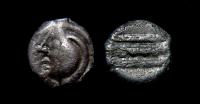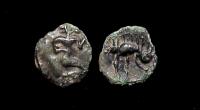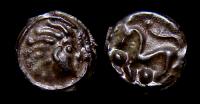What are potins?
Most collectors of ancient coins have their particular areas of interest: Roman denarii or sestertii, Greek silver or bronzes, perhaps Biblical coins. Many if not most collectors
of ancient coins outside of Europe have never heard of a potin. So what are they, who issued and used them and where and when were they minted?
 Potins - The Coins
Potins - The Coins
 |
| Aulerci Eburovices Tribe, 19x17mm, 3.1 grams |
To look at, a potin is naturally gray to black in color with a smooth hard surface, which looks almost as if it had been polished. Most have somewhat crude detail in comparison to
struck Roman and Greek bronzes. In fact, they are reminiscent of the cast Aes Grave series of the Roman Republic. The word “potin” was the name given by 19th century metallurgists
to a special alloy of bronze, which contained an unusually high percentage of tin (up to 25 percent), and quite often an appreciable percentage of lead as well. It was its
metallurgical composition that made it the choice of moneyers in Gaul, roughly the area of today’s France and Belgium, between about 100 BC and the beginning of the Roman Empire
under Augustus. There was plenty of alluvial tin to be found in northwest France and southwest England (a few hours away by sailing boat across the English Channel) and copper
mining was already well established from the Bronze Age era. It is a well known metallurgical fact that the more tin that is added to a bronze alloy, the lower the temperature at
which it melts. It can be cast into molds quickly and simply, even under primitive conditions.
 |
| Aulerci Eburovices Tribe, 15mm, 2.1 grams |
If a moneyer had a pattern, or even a coin, he could press it between two pieces of
clay, cutting a channel for pouring in the molten alloy, and in a few moments he could cast a coin. To cast a number of coins at the same time, the moneyer took two strips of
clay, pressed the obverse of the coin or pattern into one, and the reverse into the other, cutting grooves to join the impressions together, then he poured in the metal at one end
and let it cool. He would then break up the mold to extract the strips of coins, trim their edges with a sharp tool, and a new handful of coins would be ready for circulation.
 |
| Bellovaci Tribe, 17mm, 2.5 grams |
The trimmings from the flan spew went back into the melting pot and the used clay was discarded and the process was repeated until the proper amount of currency had been minted.
When a worn coin was used as the host for the mold, the end result would be a copy of the worn coin. Many times a coin that looked to be worn was actually “as struck.” For such a
simple process, the finished product had one significant advantage over struck bronze coins. The coin-mold cavity could not be off center unless the clay strips were misaligned.
This eliminated the off-center strikes commonly seen on Roman and Greek coins. Designs ran the full gamut from crude to quite complex; each with its own stylized Celtic flair. So
now we know what potins are, and how they were made. The next question is, who issued them and used them?
 Potins - Their Issue and Distribution
Potins - Their Issue and Distribution
 |
| Carnutes Tribe, 18mm, 3.6 grams |
Potins were essentially produced by the Celts who lived in Gaul, having migrated westward over a number of centuries from their original homelands in central Europe. They were an
adventurous, dynamic race. They were expert ironworkers and developed ploughs which transformed a wooded and uncultivated land into a fertile homeland. The exploits of the Celts
were not unlike those of the pioneers of the 19th century American west. The Celts quickly organized themselves into tribal communities with permanent dwellings with each tribe
dominating its own territory. Such villages suggested a developing society, as well as an obviously defendable stronghold. Although the Celts do not appear to have had a written
language of their own, we know from the writings of contemporary Romans and Greeks who visited them that their organization and living standards had developed well beyond the
 |
| Leuci Tribe, 17mm, 3.2 grams |
subsistence level. It is not too fanciful to assume that products were bought and sold rather than simply bartered, which meant that currency was needed for day-to-day commerce.
The Celts were a warlike race, and the Greeks had taken advantage of their military capabilities and recruited them as mercenaries since the middle of the 4th century BC.
Therefore, as the Celtic society was developing in the west, they already knew about monetary systems and coinage from their service to the Greeks. It was not long before they
started production of their own coinage based on the gold staters of Philip of Macedon, silver drachms and tetradrachms of Philip, Alexander the Great and Thasos. These copies of
Greek coinage were the earliest coinage minted by the Celts. Such coins, however, were too valuable for everyday use; it is thought they were mainly used for distribution as
prestigious gifts between tribal leaders, who took ceremony very seriously and liked to show off their possessions. Silver and gold coinage had a very high value and what was
 |
| Carnutes Tribe, 16mm, 3.5 grams |
needed was a coinage for common people to make day-to-day purchases such as flour and oil. Potins were the perfect answer. The Celts also produced silver and bronze coins which
will be discussed in a future article. It is interesting to note that potins do not seem to have been produced to any universally accepted weight standard. Weights range from 2
to 7 grams and sizes range from 10mm to 23mm. Even within one tribe or tribal type there are many variations in size and weight. It is unknown if these were different
denominations or just one tribe’s attempt to show superiority in the area of coinage. Unlike gold and silver, potins had no intrinsic value. It can be argued that they were the
first “token coinage,” accepted by general consensus as a medium of exchange, much like today’s paper currency.
 |
| Carnutes Tribe, 18mm, 3.8 grams |
Travel was difficult and probably dangerous, so each tribe produced coins for circulation only in its own immediate area. Each tribal area was fairly small; many were only the
size of an average modern township, so it did not take a lot of coinage to supply the population of any particular tribe. Considering that potins were minted for less than 100
years, and each type for a small population base, it is amazing that they are available at moderate prices. In comparison, Roman coins were minted for a short duration--the reign
of an emperor--however they were minted for an entire empire, making them much more common. Potins could then be compared in scarcity to the coinage of a short reigning emperor
such as Galba. Potins could also be compared to bronze coinages of small Greek city-states and even then, potins were minted for a much shorter duration. Obviously, coins traveled
 |
| Leuci Tribe, 17mm, 5.8 grams |
with travelers and merchants and they were possibly accepted as payment for goods and services away from their tribes of issue. By drawing on written sources such as Julius
Caesar’s Gallic Wars, we know roughly where the major tribes had their bases. By noting which types and designs of potins predominated among coins found in each area, we can
fairly confidently link a particular coin-type to its probable issuing tribe.
 Potins - Their Designs and Meanings
Potins - Their Designs and Meanings
 |
| Remi Tribe, 20mm, 4.7 grams |
This brings us to the heart of potin collecting. A collector may ask: “Why do so many tribes use horses?” “Why do many potins feature wild boars?” or, “ What does a spoked wheel
on a potin signify?” The reply can only be that no one can at present give a precise unarguable answer, and this is for me probably the most fascinating aspect of the whole potin
series. We know from contemporary writers that the boar was revered as a symbol of courage, that the spoked wheel probably represents the sun or a sun god, a horse was a symbol of
the Celt’s advanced horsemanship and travel, and a horse with a bird on its back may be a Celtic derivative from the Greek Pegasus. Only considerable further research will start
to open the doors to these further meanings. It is a pleasure to ponder such things…it is part of the Celtic way! It is an enjoyable part of the hobby of potin collecting to
 |
| Senones Tribe, 17mm, 4.1 grams |
decide what a certain image meant to Celts of that day. One potin of the Remi tribe depicts a person walking r. with what appears to be a torc, a necklace worn by warriors and
nobility in one hand, and what looks to be a spear in the other. The hair is done in a single long braided pigtail. Knowing that the torc symbolizes either kingship, or at least
clan leadership, or the ornament of a leading warrior, we can assume that the figure is a leader of some sort. The spear would signify a warrior, or perhaps a leader or king. I
have also seen this figure described as a Celtic god dancing with a torc and snake. This, in essence, is the beauty of potins. They are largely open to interpretation and
speculation.
 Collecting Potins - Some Practical Techniques
Collecting Potins - Some Practical Techniques
 |
| Remi Tribe, 20mm, 4.7 grams |
Many collectors already have an area of specialty that they collect; mine is potins. Below I have listed a few ideas on starting a collection of potins. Starting a full collection
may not be the goal of most collectors; I would however suggest adding a few to highlight either your Greek or Roman collections. Potins range in price from $30 to several hundred
dollars depending on quality and scarcity. My personal favorite is the Remi potin described above which could be purchased for $40 to $150 depending on condition. Atlas de
Monnaies Gauloises by Henri De La Tour is the standard reference for Gallic Celtic coinage, and can be purchased for less than $30. There are various ways of starting a potin
collection and a number of approaches are possible. There are a good variety of types available considering that potins are overall scarce to rare coins.
- Buy a few to highlight your Roman collection as enemies of Julius Caesar & Augustus.
- Buy a few to highlight your Greek collection as allies of the Greek world.
- As coin types vary among tribes, search out a specimen for each tribe within your designated price range.
- Go for themes: collect potins that show horses, for instance, or perhaps boars.
- With the smaller tribes, collect an entire set of all coins issued for that tribe.
- Concentrate on obverse types: the “wild man head” and “bald head” are just two examples.
- Concentrate on reverse styles, as these vary dramatically.
Potins are not as challenging to attribute as deciphering IMP CAES NER TRAIANO OPTIMO AVG GER DAC PARTHICO PM TR P COS VI PP from a well worn bronze of Trajan, or identifying the
bust of Amazon Lykastia on a Greek bronze. They are a Celtic art form that is intricately woven like a Celtic knot into both the Roman and Greek worlds.

 |
| Marc Breitsprecher |
About Marc Breitsprecher
He lives with his wife Melissa and 2 sons in Grand Marais, MN on the shores of Lake Superior; just a stone's throw from the Canadian border. He started collecting coins at the age of 7 and ancient coins at the age of 17 with the purchase of a Pontius Pilate bronze. Over the years he has collected Greek, Biblical and Celtic coins and has started to collect Roman coins in earnest in the last few years. Other activities he enjoys include fly-fishing for the ever-elusive brook trout, canoeing and upland bird hunting.





















